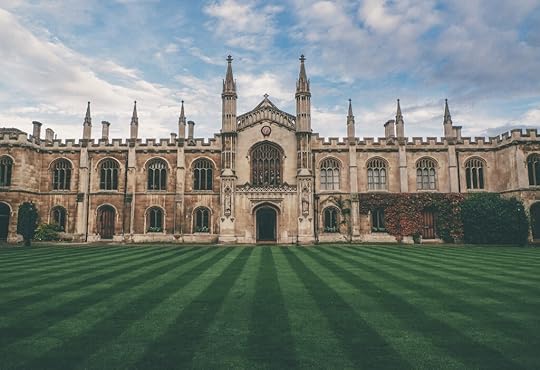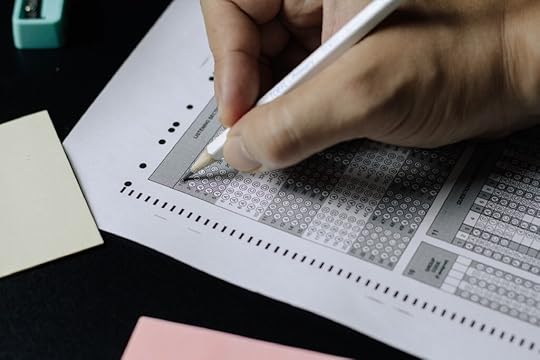C.C. Francis's Blog
August 21, 2022
9 Ideas that can Transform your Life
August 20, 2022
10 Tips for Succeeding in Law School
It’s not half as hard as people make it out to be — but you need the right habits.
August 19, 2022
6 Soft Skills that will Supercharge a Legal (or Corporate) Career
August 17, 2022
How a $100 Solar System Charges all my Electronics for Free
 Photo by Tschernjawski Sergej on UnsplashOne foldable solar panel the size of a sheet of paper charges my iPhone, iPad, Chromebook, and VR.
Photo by Tschernjawski Sergej on UnsplashOne foldable solar panel the size of a sheet of paper charges my iPhone, iPad, Chromebook, and VR.When people think of home solar, they imagine spending $15,000–25,000 for panels — another $10,000+ on a Tesla Powerwall or the like.
For $100, my iPhone, iPad, Chromebook, and Quest 2 all charge for free.
A foldable 21W solar panel sits in my driveway right now, charging two 25,000 mAh batteries. In two days, both batteries will be full.
The 21W panel (about the size of an sheet of paper, folded) was $40.The Li-ion batteries (each about the size of an iPhone) were $30 each.Both are from Amazon. Both use USB-C for input and output.
In two days, I’ll conservatively net 50,000 mAh (about 250 Wh of power at 5V). That’s 25,000 mAh/day.
Consider the battery capacities of personal electronics:
iPhone 12 : 2,815 mAh 7th-Gen iPad Pro : 9,720 mAh Asus C302C Chromebook Flip : 5,270 mAh Meta Quest 2 : 3,640 mAhCombined, these gadgets store 21,445 mAh.
One 21W solar cell adds more power every day than all of my devices combined can store.
Portable batteries rapidly charge from USB-C output. I don’t have to worry about plugging anything into a wall. I don’t worry about whether my devices are charged, and I don’t feel guilty about charging them.
It’s one of the best $100 I ever spent.
Join Medium with my referral link - C.C. Francis
[image error]How to Fix the “Metaverse” — 3 Steps to Mainstream VR
Meta’s vision has promise, but it continuously flounders on execution.
August 16, 2022
How to Go to Law School without Student Debt — and Why it Matters
 Photo by Giammarco on UnsplashHow to Go to Law School without Student Debt — and Why it MattersYou don’t have to be a genius, or have family money, to launch a legal career on the right trajectory.
Photo by Giammarco on UnsplashHow to Go to Law School without Student Debt — and Why it MattersYou don’t have to be a genius, or have family money, to launch a legal career on the right trajectory.In 2012, I fielded multiple admission offers from excellent law schools — with tuition ranging anywhere from 0-$5,000/year.
“Sticker” tuition at these same schools is $60,000–80,000/year.
When I graduated, I had no debt.
By that same point, many of my peers had taken on the equivalent of a second mortgage. Because of their debt, they had no bargaining power — no choice but to work for the largest firm and the largest salary they could find. This often involved copious night and weekend work in thankless environments, akin to a medical residency. Before these young lawyers could ever dream of owning a home, they would need to pay down $250,000+ in non-dischargeable debt — often by working 12-hour+ days in extreme stress.
“Golden Handcuffs” + student loans = a recipe for problems.Large law firms are notorious for viewing new attorney hires as expendable: for wearing down junior lawyers’ physical and mental health, and for replacing them as soon as they resign. In law, this is known as “Associate churn.”
Law firms like these are known as “Golden Handcuffs” — they provide a high level of income, along with a very difficult life (especially for junior lawyers). It’s not ubiquitous in all large firms, but it is common.
Alum Nina Totenberg to LAW Grads: "Beware the Golden Handcuffs"
[T]hen suddenly you’re going to be 60 years old, wanting the opportunity to do something else, and you’ll only have a track record with billable hours.
-Nina Totenberg, TheRecord.
At big firms, successful late-career Equity Partners can bring in seven figures of annual profit (accounting for up to 75% of their Associates’ billable time). This means they can get away with a lot. Even one difficult Partner can deteriorate the culture of a national law firm that distributes work throughout its offices.
The negative consequences of some law firm cultures are apparent in lawyer mental health statistics.
Lawyer Depression: Recognizing the Signs and Dealing With It | Clio
7.1% of all adults in the United States suffer from depression.
That same statistic is 31.2% for all lawyers. 4x higher.
In short, “Big Law” can be a turbulent experience for the unwary. It is a career path to be approached with caution, and with the most leverage possible.
That is not to say that large law firms don’t produce some of the best work product in the industry. There’s a reason large companies usually hire large law firms. But need erodes bargaining power. Joining a large law firm as a junior lawyer out of necessity/financial vulnerability is a career and health risk. Big Law employment is not something to consider lightly, or on account of six-figure debt. Choices keep you from making mistakes. You will want options when you start to shop around for a 2L Summer Associate position or for post-Bar employment.
In contrast to many of my law school peers, law school loan payments don’t come due every month for me. I can do whatever I want with my law degree. Government work, business, volunteer work, consulting, writing books… all doors are open.
How did I make this happen?
It wasn’t need-based aid — though I might have qualified. (Before law school, I was working two jobs that collectively paid about $40,000 per year.)It’s not family money — my parents weren’t able to afford law school tuition any more than I was.It’s not genius-level intellect. I’m smart, but I’ve never been someone who got ahead without putting the hours in.Tuition-free law school is the result of knowing three simple facts — which, for whatever reason, many prospective law students seem to miss.
 Photo by Vadim Sherbakov on Unsplash1) (Almost) All Law Schools Price-Discriminate.
Photo by Vadim Sherbakov on Unsplash1) (Almost) All Law Schools Price-Discriminate.Your cost for law school is unique to you.
Most prospective students don’t seem to understand the extent of price discrimination in legal education.
The sticker price for law school is like the sticker price for a car. It’s subject to negotiation. The price you actually pay is a price that’s only for you.
Legal education has a “pecking order” — prestige is paramount.Law is hierarchical. It’s borderline-obsessed with prestige.
That may be unhealthy. It may exemplify some of the very worst attitudes in America. It may perpetuate inequality or privilege. But it doesn’t ever seem to change.
Vault 100 Rankings: The Most Prestigious Law Firms In America (2023)
For better or for worse, the consistent focus on name recognition seems to suggest that prestige serves a purpose in the industry. Some people, like Jordan Peterson (famous, or infamous, for his “lobsters” analogy), believe that strict hierarchies are inherent in evolutionary biology and critical for the functioning of competitive industries. I tend to think that law uses prestige as a stand-in for quality because there aren’t many other metrics by which to gauge success.
Regardless of whether the industry’s emphasis on name brands is right or wrong, it exists. It is something you will need to deal with. Almost all Supreme Court Justices come from just a handful of law schools. You can conceive of the “prestige” factor of an application to law school or for legal employment as the single most important predictor of its success. If you understand this about law from the start, you’re already at an advantage.
Law schools are focused on improving their U.S. News rankings.As to law school, prestige means one thing — U.S. News rankings.
The Best Law Schools in America, Ranked
Nothing matters more to a law school administrator than improving a school’s U.S. News number. To improve these rankings, law schools have their eyes on several criteria:
LSAT score;Average undergrad GPA;Undergrad institution; andAverage graduating salary.The first three criteria tend to be predictive of the fourth. Candidates with above-average undergraduate GPAs from good institutions and high LSAT reflect the “prestige” administrators are looking for. These candidates are ripe for recruitment into top institutions.
You can’t change where you went to college, and you can’t change your college GPA. But you can change your LSAT score. This is the opening to achieve a full-ride “merit scholarship” (i.e., negotiated discount) to a school with a comparatively lower ranking.
How to Score a Full-Ride Law School Scholarship
There are 199 ABA-accredited law schools in the United States. Most law schools outside of the elite national U.S. News “Top 14” (and even some inside that rarified group) offer full scholarships to candidates based solely on the quality of their application materials.
There is a trade-off here.
The better-ranked your law school is, the more momentum your career will have (on average). More firms are interested in top schools’ grads. More prestigious clerkships and government career paths will be available to them.On the other hand, a comparatively lesser-ranked school is likely to offer more of a tuition discount for the right candidate. If you’re well above a school’s average LSAT and/or average undergraduate GPA (especially both), schools outside the T14 are more likely to invest in you in the hopes of raising their numbers and improving their rankings. Photo by Nguyen Dang Hoang Nhu on Unsplash2) Preparation for the LSAT Can Add 40+ Percentile to your Score.
Photo by Nguyen Dang Hoang Nhu on Unsplash2) Preparation for the LSAT Can Add 40+ Percentile to your Score.Standardized testing measures persistence.
The LSAT can be thought of like an IQ test.
It’s scored 120–180. ~150 is the average. The higher the score, the higher your likelihood of attaining a full-tuition scholarship. LSAT performance has essentially nothing to do with the practice of law. Instead, it gauges “g,” or general ability. g, in this context, is meant to correlate with your ability to do well in law school and in the profession.
Psychometrics (of which IQ testing and the LSAT are a part) is a controversial field that relies on inferences and correlations to predict outcomes. IQ testing has historically been used as justification for all manner of wrongs — everything from racial discrimination, to eugenics; even forced sterilization programs.
But right or wrong, the “prestige ladder” of law starts with the LSAT. And like other standardized tests, the LSAT is beatable. The key is allowing time to prepare.
Spend months preparing for the LSAT, take dozens of practice tests, and you can raise your initial score by 15+ points.
That means from a starting score of 150 (50th percentile), you can end up with a score of 165 (90th percentile).
For $1,000–2,000, some test prep companies guarantee a 15 point increase in score — with others promising a minimum score of 165 (90th percentile). A 165 is a good score: enough to demand at least a partial scholarship at many competitive law schools.
If your starting score is 160 (or if you’re able to improve further), your score can end up around 175 — 99th+ percentile and above-average for any school in the country. This highly competitive outcome will open many doors, in the short and long term.
Companies wouldn’t issue these guarantees if students didn’t consistently and dramatically improve their scores on this test.
 Photo by Rock Staar on Unsplash3) A Few Months of LSAT Preparation Can be Worth $250,000 — and Years of your Life.
Photo by Rock Staar on Unsplash3) A Few Months of LSAT Preparation Can be Worth $250,000 — and Years of your Life.Dedicate three to six months to preparing for the LSAT.
Take at least a dozen practice tests before you sit for the real thing. You would never go into the Bar Exam cold — so don’t assume you can do the same for the LSAT. (To do so is to miss out on the additional 15 points, minimum.)
If you forego full-time employment for six months to raise your LSAT score by 15 points, you may be saving yourself a quarter-million dollars in student loans during that period of time. Think about that for a moment — when will you ever make $500,000/year, after tax? Probably not until you’re an Equity Partner at a large law firm (if that life is what you decide you want).
Some test prep plans are as little as $300. If you can spare the time and money, LSAT preparation for a future lawyer is probably the single best investment you could make for your long-term career, financial future, and health.
With a top LSAT score, you’ll be more likely to compete for a spot at top schools — and to angle for scholarships down the rankings ladder. As soon as a T14 school offers admission, or a peer school offers a scholarship with an admission offer, share that information with other schools’ admissions contacts. They will match or increase offers if they are interested in recruiting you.
Putting the time in on the LSAT before law school will:
Save you years of debt;Give you the confidence to succeed in law school;Make you more employable (if you attend a higher-ranked school);Afford you bargaining power when choosing a law firm after graduation (if you take a scholarship); andPrevent you from joining the wrong law firm out of necessity.*This article does not constitute legal or financial advice. These are only general suggestions and should not be relied upon in making individual decisions.
Join Medium with my referral link - C.C. Francis
[image error]August 14, 2022
5 Disruptive Clean Tech Innovations to Reverse Climate Change
(1) Perovskite Solar Cells; (2) Sodium-Ion Batteries; (3) Nanomembrane Desalination & Pumped Hydro; (4) Aeroponics & Reforestation; and…
July 8, 2022
Sustainable Ocean Cities are on the Horizon
One solution to the housing, climate, and fiscal crises may be settling the seas.
July 2, 2022
4 Battery Technologies that May Change Everything
June 18, 2022
The Answer to California’s Water Crisis is Imagination
What the world’s former innovation capital can learn from 21st-Century Dubai.











